Lights Over Lapland is excited to announce that our aurora webcam will be up and running 365 days per year! You can now enjoy watching the Midnight Sun and all of the other drama in the sky above Abisko National Park, Sweden here. | | |
THE CRESCENT MOON AND ALDEBARAN: After passing Venus last night, the crescent Moon is en route to another close encounter--with Aldebaran, an orange giant star in the constellation Taurus. Look for them in the west after sunset as the sky fades to deep twilight. The Da Vinci Glow will also be visible; more on that below. [sky map] [photos]
WHAT IS THE DA VINCI GLOW? Five hundred years ago, Leonardo da Vinci proposed an outlandish theory explaining why the Moon's surface glows after lunar nightfall. Turns out, his idea was correct, and this week is a great time to see the "Da Vinci Glow." Mark A. Brown witnessed it last night when he was photographing the Moon-Venus conjunction over Alburnett, Iowa:
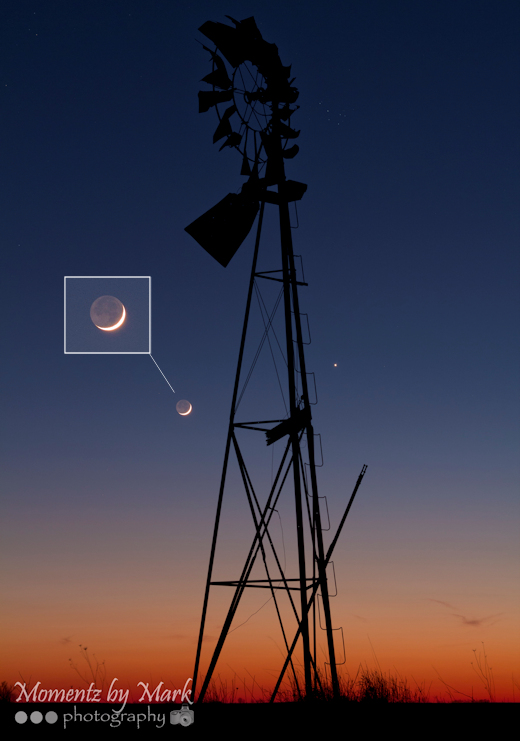
The Da Vinci Glow--also known as "Earthshine"--makes the entire lunar disk visible even when the sunlit fraction is just a few percent. "It was gorgeous," says Brown.
For much of human history, people marveled at the faint image of the full Moon inside the arms of the crescent. Where did it come from? No one knew until the 16th century when Leonardo figured it out. He realized that sunlight reflected from Earth lit up the lunar night.
Visualizing this in the 1500s required a wild kind of imagination. No one had ever been to the Moon and looked "up" at Earth. Most people didn't even know that Earth orbited the sun. Copernicus' sun-centered theory of the solar system wasn't published until 1543, twenty-four years after Leonardo died.
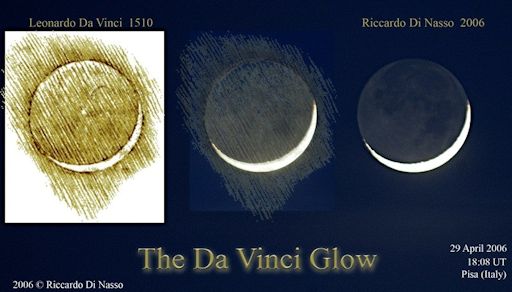
Above: Da Vinci's sketch of Earthshine in 1510 vs. Italian astronomer Riccardo Di Nasso's photo of Earthshine in 2006.
Wild imagination was one thing Leonardo had in abundance. His notebooks are filled with sketches of flying machines, army tanks, scuba gear and other fantastic devices centuries ahead of their time.
In Leonardo's Codex Leicester, circa 1510, there is a page entitled "Of the Moon: No Solid Body is Lighter than Air." He states his belief that the "ghostly glow" is due to sunlight bouncing off Earth's oceans and, in turn, hitting the Moon. 500 years later, we know that Earth's clouds (not oceans) do most of the reflecting; but that is a quibble. Leonardo understood the basics well enough.
Go outside tonight and look to the sky. The Da Vinci Glow is waiting....
Realtime Space Weather Photo Gallery
MOTHER'S DAY IS LESS THAN 1 MONTH AWAY: Nothing says "I Love You" like a heart-shaped pendant from the edge of space. On March 17, 2018, the students of Earth to Sky Calculus flew an array of cosmic ray sensors to the stratosphere onboard a giant helium balloon. This pendant went along for the ride:
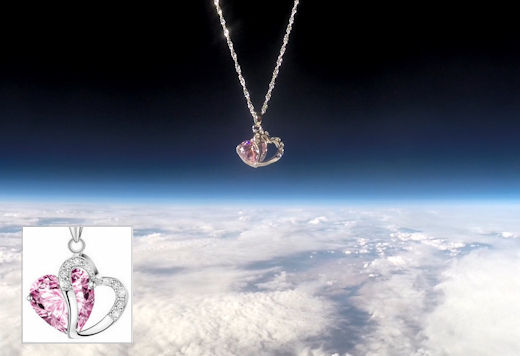
You can have it for $99.95. The students are selling these pendants as a fund-raiser for their cosmic ray monitoring program--and they make great Mother's Day gifts. All proceeds support atmospheric radiation measurements and hands-on STEM education.
Each pendant comes with a greeting card showing the jewelry in flight and telling the story of its journey to the stratosphere and back again. Mom-satisfaction guaranteed.
Far Out Gifts: Earth to Sky Store
All proceeds support hands-on STEM education
SOLAR WIND, INCOMING: A hole has opened in the sun's atmosphere, and it is spewing a stream of solar wind toward Earth. This extreme UV image from NASA's Solar Dynamics Observatory shows the gaseous rift:
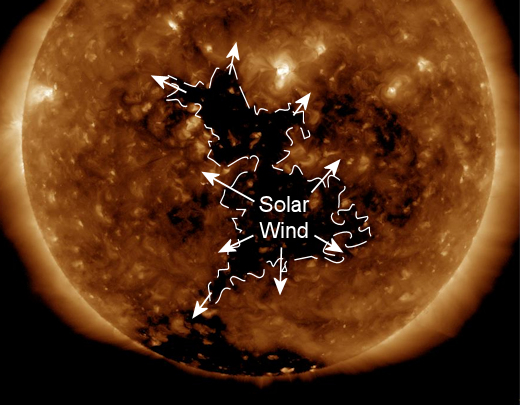
G1-class geomagnetic storms and polar auroras are possible when the solar wind arrives on April 19-20. Sky watchers between 50o and 60o N latitude should also be alert for STEVE, an aurora-like phenomenon which tends to appear in that latitude range during springtime geomagnetic storms. Free: Aurora Alerts
Realtime Aurora Photo Gallery
Every night, a network of
NASA all-sky cameras scans the skies above the United States for meteoritic fireballs. Automated software maintained by NASA's Meteoroid Environment Office calculates their orbits, velocity, penetration depth in Earth's atmosphere and many other characteristics. Daily results are presented here on Spaceweather.com.
On Apr. 18, 2018, the network reported 18 fireballs.
(18 sporadics)

In this diagram of the inner solar system, all of the fireball orbits intersect at a single point--Earth. The orbits are color-coded by velocity, from slow (red) to fast (blue). [Larger image] [movies]
Potentially Hazardous Asteroids (
PHAs) are space rocks larger than approximately 100m that can come closer to Earth than 0.05 AU. None of the known PHAs is on a collision course with our planet, although astronomers are finding
new ones all the time.
On April 18, 2018 there were 1907 potentially hazardous asteroids.
 |
Recent & Upcoming Earth-asteroid encounters: | Asteroid | Date(UT) | Miss Distance | Velocity (km/s) | Diameter (m) |
| 2018 GP | 2018-Apr-13 | 4.4 LD | 8.8 | 14 |
| 2018 GV1 | 2018-Apr-13 | 4.8 LD | 8.9 | 12 |
| 2018 GD5 | 2018-Apr-14 | 3.6 LD | 6 | 10 |
| 2014 UR | 2018-Apr-14 | 9.3 LD | 4.4 | 17 |
| 2018 GH2 | 2018-Apr-14 | 14.3 LD | 7.1 | 22 |
| 2018 GE3 | 2018-Apr-15 | 0.5 LD | 29.6 | 61 |
| 2018 GC2 | 2018-Apr-17 | 9 LD | 4.9 | 15 |
| 2018 GP4 | 2018-Apr-17 | 11.4 LD | 9.3 | 18 |
| 2018 GK4 | 2018-Apr-17 | 5.9 LD | 10.8 | 20 |
| 2018 GS3 | 2018-Apr-20 | 8.5 LD | 19.8 | 22 |
| 2016 JP | 2018-Apr-20 | 12 LD | 12.7 | 214 |
| 2018 GR1 | 2018-Apr-21 | 18.3 LD | 16.4 | 53 |
| 2018 GG4 | 2018-Apr-23 | 9.8 LD | 14.9 | 19 |
| 2012 XL16 | 2018-Apr-23 | 15.8 LD | 6.1 | 28 |
| 2018 GH | 2018-Apr-25 | 14.6 LD | 10.7 | 89 |
| 2018 GH5 | 2018-Apr-27 | 12.2 LD | 12.7 | 32 |
| 2018 GB2 | 2018-Apr-27 | 17.1 LD | 14.6 | 95 |
| 2013 US3 | 2018-Apr-29 | 10.1 LD | 7.7 | 214 |
| 2018 GO4 | 2018-Apr-29 | 11.8 LD | 8.6 | 45 |
| 2018 GY1 | 2018-Apr-29 | 13.2 LD | 16.7 | 138 |
| 2018 FV4 | 2018-Apr-29 | 17.7 LD | 6.5 | 58 |
| 2002 JR100 | 2018-Apr-29 | 10.8 LD | 7.7 | 49 |
| 1999 FN19 | 2018-May-07 | 9.7 LD | 5.7 | 118 |
| 2016 JQ5 | 2018-May-08 | 6.3 LD | 10.4 | 9 |
| 388945 | 2018-May-09 | 6.5 LD | 9 | 295 |
| 2018 GR2 | 2018-May-11 | 13.4 LD | 9.9 | 110 |
| 1999 LK1 | 2018-May-15 | 13.3 LD | 10 | 141 |
| 2018 GL1 | 2018-May-18 | 14.3 LD | 5.2 | 66 |
| 68347 | 2018-May-29 | 9.5 LD | 13.3 | 389 |
| 2013 LE7 | 2018-May-31 | 17.8 LD | 1.7 | 12 |
| 2018 EJ4 | 2018-Jun-10 | 5.6 LD | 6.2 | 195 |
| 2015 DP155 | 2018-Jun-11 | 9 LD | 4.4 | 170 |
Notes: LD means "Lunar Distance." 1 LD = 384,401 km, the distance between Earth and the Moon. 1 LD also equals 0.00256 AU. MAG is the visual magnitude of the asteroid on the date of closest approach. | | Cosmic Rays in the Atmosphere |
Readers, thank you for your patience while we continue to develop this new section of Spaceweather.com. We've been working to streamline our data reduction, allowing us to post results from balloon flights much more rapidly, and we have developed a new data product, shown here:

This plot displays radiation measurements not only in the stratosphere, but also at aviation altitudes. Dose rates are expessed as multiples of sea level. For instance, we see that boarding a plane that flies at 25,000 feet exposes passengers to dose rates ~10x higher than sea level. At 40,000 feet, the multiplier is closer to 50x. These measurements are made by our usual cosmic ray payload as it passes through aviation altitudes en route to the stratosphere over California.
What is this all about? Approximately once a week, Spaceweather.com and the students of Earth to Sky Calculus fly space weather balloons to the stratosphere over California. These balloons are equipped with radiation sensors that detect cosmic rays, a surprisingly "down to Earth" form of space weather. Cosmic rays can seed clouds, trigger lightning, and penetrate commercial airplanes. Furthermore, there are studies ( #1, #2, #3, #4) linking cosmic rays with cardiac arrhythmias and sudden cardiac death in the general population. Our latest measurements show that cosmic rays are intensifying, with an increase of more than 13% since 2015:
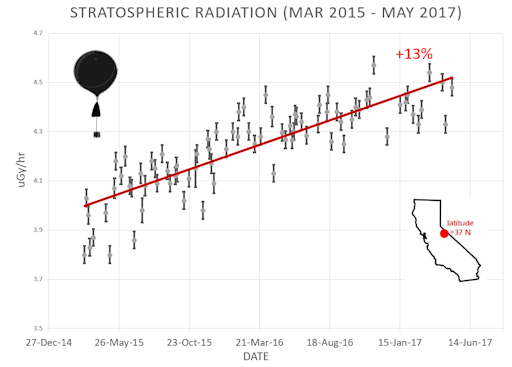
Why are cosmic rays intensifying? The main reason is the sun. Solar storm clouds such as coronal mass ejections (CMEs) sweep aside cosmic rays when they pass by Earth. During Solar Maximum, CMEs are abundant and cosmic rays are held at bay. Now, however, the solar cycle is swinging toward Solar Minimum, allowing cosmic rays to return. Another reason could be the weakening of Earth's magnetic field, which helps protect us from deep-space radiation.
The radiation sensors onboard our helium balloons detect X-rays and gamma-rays in the energy range 10 keV to 20 MeV. These energies span the range of medical X-ray machines and airport security scanners.
The data points in the graph above correspond to the peak of the Reneger-Pfotzer maximum, which lies about 67,000 feet above central California. When cosmic rays crash into Earth's atmosphere, they produce a spray of secondary particles that is most intense at the entrance to the stratosphere. Physicists Eric Reneger and Georg Pfotzer discovered the maximum using balloons in the 1930s and it is what we are measuring today.
| | The official U.S. government space weather bureau |
| | The first place to look for information about sundogs, pillars, rainbows and related phenomena. |
| | Researchers call it a "Hubble for the sun." SDO is the most advanced solar observatory ever. |
| | 3D views of the sun from NASA's Solar and Terrestrial Relations Observatory |
| | Realtime and archival images of the Sun from SOHO. |
| | from the NOAA Space Environment Center |
| | fun to read, but should be taken with a grain of salt! Forecasts looking ahead more than a few days are often wrong. |
| | from the NOAA Space Environment Center |
| | the underlying science of space weather |
 | Reviews here can help you to pick up best memory foam mattresses. |
| | These links help Spaceweather.com stay online. Thank you to our supporters! |
| | | | | | |

